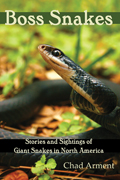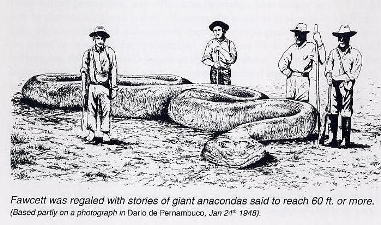On Track of The Giant Anaconda
Posted by: Loren Coleman on February 19th, 2011

The gentlemen from Atlas Obscura, behind the writing of the following article, are our friends and they came to us. They were in search of information and images. We are delighted to see their article developed into a worthwhile exploration of this topic.
Click image for full-size version
Writing from Pacaya Samiria, Peru, Joshua Foer notes:
On the Trail of a 40-Foot Anaconda
The fifth hidden wonder of South America.
Of all the crazy mythical creatures that starry-eyed monster hunters have gone in search of—the Yeti, Sasquatch, Nessie, the chupacabra—South America’s giant anaconda would seem to be the least implausible. None of the Amazon’s early explorers dared emerge from the forest without a harrowing tale of a face-to-face encounter with a humongous snake. In the 19th and early 20th centuries, it was practically a requirement of the jungle adventure genre. English explorer Percy Fawcett (of Lost City of Z fame) reportedly shot a 62-foot anaconda in 1907 while on a surveying mission in western Brazil. Cândido Rondon, who led Teddy Roosevelt’s famous journey down the River of Doubt, claimed to have measured a 38-footer “in the flesh.” In 1933, a 100-foot serpent was said to have been machine-gunned by officials from the Brazil-Colombia Boundary Commission. According to witnesses, four men together couldn’t lift its head. The photos, of course, were lost.
Had they been captured alive, any of these giants would have merited the $50,000 bounty that the New York Zoological Society (later the Wildlife Conservation Society) offered for much of the 20th century to anyone who could bring a 30-foot snake back to the Bronx Zoo. Though thousands of anacondas have been caught, measured, and released by scientists over the years, few have ever surpassed 18 feet. Still, stories of Amazonian megasnakes continue to surface every few years, and they continue to inspire credulous souls to set off into the jungle. People like Dylan and me.
We had made our way from Gocta to Iquitos, the largest city in the world that cannot be reached by road, to engage in what Loren Coleman, founder of the International Cryptozoology Museum in Portland, Maine, has dubbed “cryptotourism,” a form of adventure travel driven by the hunt for creatures that have eluded science. Most cryptotourists are truer believers than we. But that’s almost beside the point. Their expeditions sometimes seem to be as much about finding undiscovered animals as about creating an excuse to get out into some of the wildest places left on earth, to play-act as real explorers.
For rest of article, click here.

For more information about large serpents closer to home, read Boss Snakes: Stories and Sightings of Giant Snakes in North America by Chad Arment.
About Loren Coleman
Loren Coleman is one of the world’s leading cryptozoologists, some say “the” leading living cryptozoologist. Certainly, he is acknowledged as the current living American researcher and writer who has most popularized cryptozoology in the late 20th and early 21st centuries.
Starting his fieldwork and investigations in 1960, after traveling and trekking extensively in pursuit of cryptozoological mysteries, Coleman began writing to share his experiences in 1969. An honorary member of Ivan T. Sanderson’s Society for the Investigation of the Unexplained in the 1970s, Coleman has been bestowed with similar honorary memberships of the North Idaho College Cryptozoology Club in 1983, and in subsequent years, that of the British Columbia Scientific Cryptozoology Club, CryptoSafari International, and other international organizations. He was also a Life Member and Benefactor of the International Society of Cryptozoology (now-defunct).
Loren Coleman’s daily blog, as a member of the Cryptomundo Team, served as an ongoing avenue of communication for the ever-growing body of cryptozoo news from 2005 through 2013. He returned as an infrequent contributor beginning Halloween week of 2015.
Coleman is the founder in 2003, and current director of the International Cryptozoology Museum in Portland, Maine.










